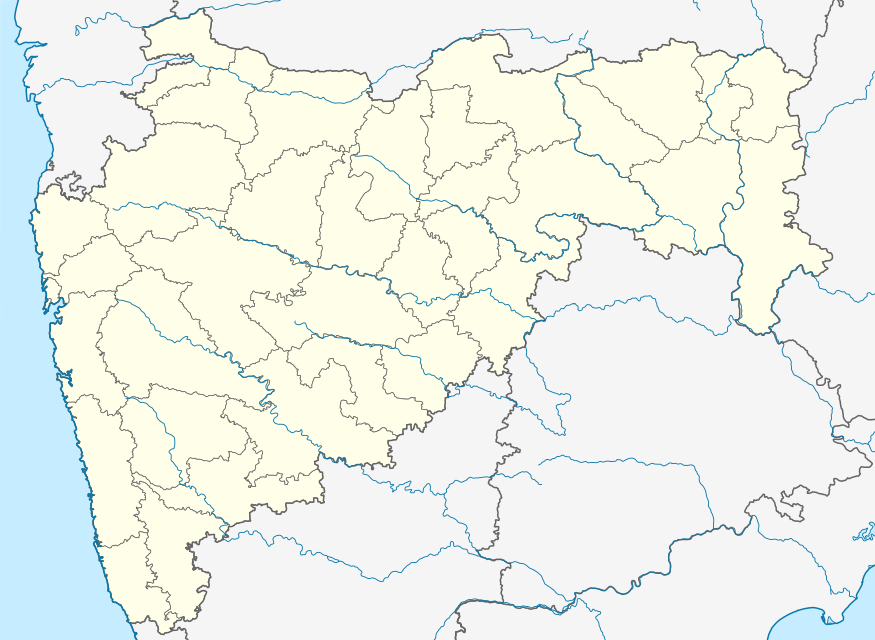Jalna, Maharashtra
Jalna ![]()
Jalna | |
|---|---|
| Nickname(s): City Of Steel, Seed Capital of India | |
 Jalna Location in Maharashtra, India | |
| Coordinates: 19.8410°N 75.8864°E | |
| Country | |
| State | Maharashtra |
| District | Jalna |
| Government | |
| • Type | Municipal council |
| • Body | Jalna Municipal Council |
| • M.L.A. of Maharashtra | Kailash Gorantyal |
| Area | |
| • Total | 81.6 km2 (31.5 sq mi) |
| Elevation | 508 m (1,667 ft) |
| Population (2011) | |
| • Total | 285,577 |
| • Rank | 127 in India |
| • Density | 3,500/km2 (9,100/sq mi) |
| Demonym(s) | Jalnekar |
| Languages | |
| • Official | Marathi |
| Time zone | UTC+5:30 (IST) |
| PIN | 431203 431213 |
| Telephone code | 02482 |
| Vehicle registration | MH-21 |
Geography
Jalna is located at 19.8410°N 75.8864°E. It has an average elevation of 508 m (1,667 ft), on the banks of the Kundalika River.[2]
Climate
| Climate data for Jalna | |||||||||||||
|---|---|---|---|---|---|---|---|---|---|---|---|---|---|
| Month | Jan | Feb | Mar | Apr | May | Jun | Jul | Aug | Sep | Oct | Nov | Dec | Year |
| Average high °C (°F) | 29 (84) |
32 (90) |
36 (97) |
39 (102) |
39 (102) |
34 (93) |
30 (86) |
29 (84) |
30 (86) |
32 (90) |
30 (86) |
29 (84) |
32 (90) |
| Average low °C (°F) | 10 (50) |
14 (57) |
19 (66) |
23 (73) |
25 (77) |
24 (75) |
22 (72) |
22 (72) |
21 (70) |
19 (66) |
15 (59) |
12 (54) |
19 (66) |
| Average precipitation mm (inches) | 1.8 (0.07) |
1.1 (0.04) |
6.6 (0.26) |
3.1 (0.12) |
28.6 (1.13) |
150.1 (5.91) |
152.5 (6.00) |
182.3 (7.18) |
156.8 (6.17) |
75.2 (2.96) |
13 (0.5) |
12.5 (0.49) |
783.6 (30.83) |
| Source: Jalna Weather | |||||||||||||
Demographics
As of 2011 census, Jalna had a population of 285,577. The total population constitute, 147,029 males and 138,485 females —a sex ratio of 942 females per 1000 males. 38,834 children are in the age group of 0–6 years, of which 20,338 are boys and 18,496 are girls. The average literacy rate stands at 81.80% with 201,829 literates, significantly higher than the state average of 67.41%.[1]
Economy
The first cotton-ginning & oil-pressing factory was established in the year 1863 by Mr. Pestonji Meherwanji.
In 1889 a cotton-spinning and weaving mill was erected in Aurangabad city, which employed 700 people. With the opening of the Hyderabad-Godavari Valley Railways in the year 1900, several ginning factories were started. In Jalna alone, there were 9 cotton-ginning factories and 5 cotton presses, besides two ginning factories at Aurangabad and Kannad, and one oil press at Aurangabad. The total number of people employed in the cotton presses and ginning factories in the year 1901 was 1,016.[3]
Jalna is the biggest producer of sweet lemons and oranges in Maharashtra.
Transport
Jalna is primarily connected with the rest of India by railway and road.
Rail
Jalna is a station located on the Secunderabad-Manmad Line of the newly created Nanded Division of South Central Railway. Formerly, it had been a part of Hyderabad Division, before divisional adjustments in 2003, which saw HYB's bifurcation. Jalna-Khamgaon railway line is sanctioned and, after being finished, will connect to Central Railway
Road
Jalna is connected to major towns of the state by state highways. Road connectivity is excellent, roads connecting to Aurangabad, Pune, Ahmednagar, Nagpur, Beed, Khamgaon, Mumbai, having been upgraded to four-lane highways. A new Mumbai–Aurangabad–Nagpur highway, passing through Jalna, is being developed
See also
References
- "District Census Handbook – Jalna" (PDF). Census of India. The Registrar General & Census Commissioner. 2011. p. 22. Archived from the original (PDF) on 14 November 2019. Retrieved 3 May 2020.
- "Maps, Weather, and Airports for Jalna, India". www.fallingrain.com. Retrieved 8 April 2017.
- Khan, Mirza Mehdy (1909). Hyderabad. Imperial Gazetteer of India. Calcutta: Government Printing Press.